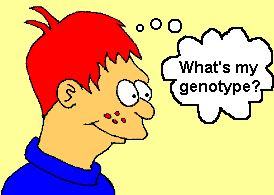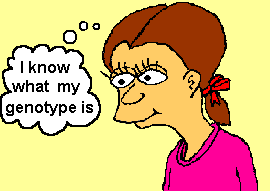Home
Genetics
Genetic
Crosses
History
Glossary
Puzzles
About
this site
Site
map
WebQuest
|
Who's the boss?
You may have wondered
how come children
may have traits (=
characteristics) that you don't see in their parents. Some people say
that traits can "skip a generation" This is true (but doesn't have
to happen - as some people think). The reason why traits can do this is
because some alleles will be masked or hidden when a different allele
is also present.
-
Remember that we
usually have two alleles for each gene. One from each parent.
-
Those alleles may be
the same, but they can be different.
-
For example, a
person
might have two alleles that code for freckles. They will
have freckles.
-
If they have two
alleles that code for no freckles they won't
have freckles.
-
What happens if
they have an allele for freckles and an allele for no freckles? Well
they will
have freckles.
-
The
allele for freckles is "stronger" than the other allele.
-
Geneticists say that
the "stronger" allele is dominant
and the allele that can be hidden is recessive.
-
For many genes in all
living things there are two or more alleles, some dominant, some
recessive and there are some that are in between - but we won't worry
about those ones at this level.
-
Summary
- Dominant alleles always show up whhen one of them is present.
While
recessive alleles will show up only if two of them are present.
Using symbols
-
It gets boring
writing down things like the
dominant allele that
gives freckles so
we use letters to symbolise alleles.
-
Capital letters are
used to show dominant alleles.
-
Small (lower case)
letters show recessive alleles.
-
We should use the
same letter for different alleles of the same gene.
-
Example:
for
freckles
we could use F
= the allele for freckles, and f
= the allele for no freckles.
-
A person with
freckles
could have alleles FF
or Ff.
-
A person without
freckles must have ff.
Genotype
and phenotype
I'll bet you have noticed
that scientists like making up lots of complicated words for you to
learn. The two above are used when talking about what alleles an
individual has compared to what they look like or what gene seems to be
having an effect.
-
Genotype
means "what alleles are present" for a certain gene.
This
can
be written as a sentence saying that the individual has two recessive
alleles or one dominant and one recessive, and so on, but it is easier
to just write down the symbols of the genes. E.g. AA or Bb or pp.
-
Phenotype means
"what is the
appearance of the organism due to its genes", or
"what genes are being expressed".
This must be written in
words - not
symbols. E.g. A freckled
person,
a tall pea plant, green leaves.


-
Example:
in
domestic
cats there is a rare recessive allele for hairlessness.
-
Most cats have two
dominant alleles for being hairy (=furry). Their genotype is HH and
their phenotype is hairy.
-
Some cats have two
recessive alleles for this gene. Their
genotype is hh
and their phenotype is hairless.
No kidding! Here are a few of photos of "sphinx" cats: A B C.
-
What would be the
genotype and phenotype
of a cat with one dominant and one recessive allele?
Another
pair of big words!
If you like learning big
words such as genotype and phenotype,
you will love the next two big words.
They are homozygous
and heterozygous.
-
Homozygous
means having two alleles the same.
-
Homozygous dominant
means having two dominant alleles of a gene, e.g. HH
-
Homozygous
recessive
means having two recessive alleles of a gene, e.g. hh.
-
Heterozygous
means having one dominant and one recessive allele, e.g. Hh.
If
you
are saying "Oh my gosh, this is all Greek to me". You are right! The
prefixes homo-
and hetero-
are from the Greek language. You may well have heard of them used with
other words where you want to show "same" or "other". E.g. Remember homologous
chromosomes? Meaning chromosomes having the same shape. Homogenised
milk has been treated to make it the same all the way through to stop
its cream separating out. Heterogeneous
means varied in content
or non-uniform.
The -zygous bit relates to the zygote which is the cell formed when
sperm and egg meet. So heterozygous means zygote formed from unlike
gametes. Homozygous means zygote
formed from
similar gametes.
And
by the way, if you are clever and know that the scientific name for
humans is Homo
sapiens, you might also know
that this Homo
comes from Latin, not Greek and means Man. |
|
 A site for
learning
about basic genetics
A site for
learning
about basic genetics A site for
learning
about basic genetics
A site for
learning
about basic genetics
